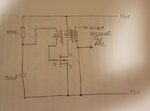jonathen
Newbie level 4

Im trying to make a plasma lighter, childish but i don't care. I have this small transformer that has 2 slots, primary and sec coils, but I don't know what voltage i need for the arc. I want to run it off of a 6v or 3v batteries, but i have no clue. The transformer I think was a step down. I tried to do math, thinking 60v would be right, primary coil would be wound 209 times (i might of ran a little less) and the sec winding would be 2029 (somewhere around there). Will that make 6v to 60v?
Am I right with the 60v anyway, and i might just be wasting your time, sorry. (about 1/8in or 3.17mm would be the gap) The core is 1 cm by 1.1 cm, I don't know the size of the wires, one (im thinking the primary) was like mm or smaller, but the other one WAS way smaller, less then normal thread. Rember im a bloody noob! This transformer came from a 4-6v battery charger, for rc cars (not the GOOD rc cars, the crapy one's, Newbight brand i think) Lastly what kind of components would i need, mosfet? diode?????
Am I right with the 60v anyway, and i might just be wasting your time, sorry. (about 1/8in or 3.17mm would be the gap) The core is 1 cm by 1.1 cm, I don't know the size of the wires, one (im thinking the primary) was like mm or smaller, but the other one WAS way smaller, less then normal thread. Rember im a bloody noob! This transformer came from a 4-6v battery charger, for rc cars (not the GOOD rc cars, the crapy one's, Newbight brand i think) Lastly what kind of components would i need, mosfet? diode?????


